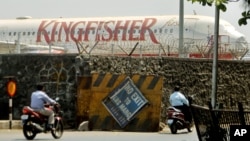NEW DELHI —
In India, a crisis gripping what was once the country's second largest airline has turned the spotlight on the struggling aviation industry. Until just a year ago, Kingfisher Airlines operated both domestic and international flights and was one of India’s premier carriers.
But its fleet has been grounded since the start of the month after employees went on strike to protest unpaid wages. And even though employees have resumed work, the airline still faces an uncertain future.
Kingfisher’s license was suspended by the aviation regulator after it failed to address concerns about how it plans to provide a safe, reliable and efficient service given the financial crunch faced by the airline. Over the past year, Kingfisher has piled up losses estimated at $ 1.5 billion and has been forced to reduce its operations.
The crisis at Kingfisher reflects the larger problems faced by India’s aviation sector. Analysts say the high operating costs in India make it difficult for most airlines to turn in profits.
India's aviation fuel is among the most expensive in the world due to high local taxes, points out Amber Dubey, director of aerospace at consulting group KPMG India.
“Nowhere in the world, it happens like this," said Dubey. "The landed cost is 55 to 60 percent costlier than competing locations like Dubai and Singapore. No way can our aviation sector absorb that. If the raw material is taxed at a very high level, you can well imagine the impact it has on the final product, which is the air ticket.”
Analysts say the rising cost of an air ticket has dampened demand. Only one of India’s six carriers has posted a profit in recent years.
The government recently relaxed investment policies and allowed foreign airlines to buy stakes of up to 49 percent in domestic carriers. This could be a lifeline for an industry looking for a source of funding.
Investors, especially those in the Middle East and East Asia, are attracted by the long-term potential of the Indian market, said Dubey.
“There’s been a lot of interest. There are lots of conversation happenings behind the scene. Once some more reforms happen, we could see one or two deals happening in the existing airlines and we might also see one or two new airlines being set up because that is another strategic option global airlines have," Dubey said. "Someone like Emirates or Singapore Airlines, all these guys have 300, 400 aircraft. They can always take out five aircraft and lease them to their Indian subsidiary.”
Among those scouting for a foreign partner to rescue its fortunes is Kingfisher. But analysts say it may be tough for the ailing carrier to find a partner to pump in capital.
But its fleet has been grounded since the start of the month after employees went on strike to protest unpaid wages. And even though employees have resumed work, the airline still faces an uncertain future.
Kingfisher’s license was suspended by the aviation regulator after it failed to address concerns about how it plans to provide a safe, reliable and efficient service given the financial crunch faced by the airline. Over the past year, Kingfisher has piled up losses estimated at $ 1.5 billion and has been forced to reduce its operations.
The crisis at Kingfisher reflects the larger problems faced by India’s aviation sector. Analysts say the high operating costs in India make it difficult for most airlines to turn in profits.
India's aviation fuel is among the most expensive in the world due to high local taxes, points out Amber Dubey, director of aerospace at consulting group KPMG India.
“Nowhere in the world, it happens like this," said Dubey. "The landed cost is 55 to 60 percent costlier than competing locations like Dubai and Singapore. No way can our aviation sector absorb that. If the raw material is taxed at a very high level, you can well imagine the impact it has on the final product, which is the air ticket.”
Analysts say the rising cost of an air ticket has dampened demand. Only one of India’s six carriers has posted a profit in recent years.
The government recently relaxed investment policies and allowed foreign airlines to buy stakes of up to 49 percent in domestic carriers. This could be a lifeline for an industry looking for a source of funding.
Investors, especially those in the Middle East and East Asia, are attracted by the long-term potential of the Indian market, said Dubey.
“There’s been a lot of interest. There are lots of conversation happenings behind the scene. Once some more reforms happen, we could see one or two deals happening in the existing airlines and we might also see one or two new airlines being set up because that is another strategic option global airlines have," Dubey said. "Someone like Emirates or Singapore Airlines, all these guys have 300, 400 aircraft. They can always take out five aircraft and lease them to their Indian subsidiary.”
Among those scouting for a foreign partner to rescue its fortunes is Kingfisher. But analysts say it may be tough for the ailing carrier to find a partner to pump in capital.











